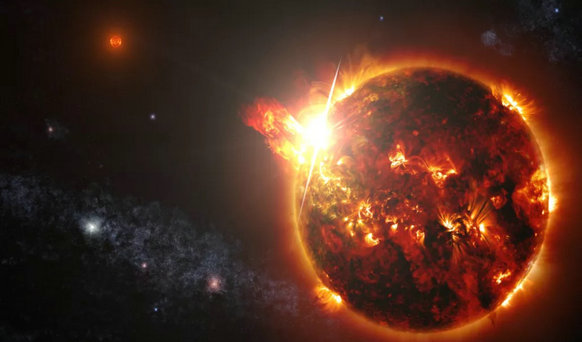LAMOST helps to determine the parameters of 300,000 M dwarfs
M dwarf stars are very-low mass stars with reddish color. Their masses are only 0.1-0.6 times the solar mass, and their temperature is about 2000-3000 degrees lower than that of the Sun.
Although M dwarf stars are small, they account for about 70% of the total number of stars in the Milky Way, dominating the faint magnitudes of the Galaxy.

Fig.1: Imagining red dwarfs. (copyright@https://www.space.com/23772-red-dwarf-stars.html)
Initial mass function (IMF) is an empirical function that describes the initial distribution of masses for a population of stars, which is one of the most fundamental assumptions of astrophysics. The M dwarf stars determine the shape of the low-mass end of the IMF.
By studying the mass distribution of M dwarf stars and whether it varies with their environment such as metallicity and cosmic time, we can better understand the issues of star formation and galaxy evolution. Moreover, they and even help us gain a deeper understanding of the question that how many obscure low-mass faint objects exist in the masses of unobserved galaxies.
Because M dwarf stars have lifetime longer than the age of the universe, they can characterize multiple stellar populations with various ages and metal abundances. In addition, these stars are also the main type of stars in the search for exoplanet habitability.
Based on the LAMOST low-resolution spectra, a new study led by PhD Candidate Jiadong Li and Prof. Chao Liu from National Astronomical Observatories of Chinese Academy of Sciences (NAOC) has estimated the stellar parameters (effective temperature and metallicity) of about 300,000 M dwarf stars, providing the largest spectroscopic M dwarf stellar parameter catalog.
Using the catalog of APOGEE survey and the BT-Settl stellar atmosphere template, the researchers accurately measured the effective temperatures and metallicities of about 300,000 LAMOST-observed M dwarfs with the SLAM algorithm proposed by Dr. Bo Zhang and Prof. Chao Liu (Zhang et al. 2020). The precisions were in good agreement with those from different surveys.
The results have been published in The Astrophysical Journal Supplement Series in this April.

Fig.2: Left: comparison between the metallicity determined in this work and the [Fe/H] from OCCAM survey. Right: distribution of the [M/H] difference. (Credit: Jiadong Li )
This work provides the first large and homogeneous spectroscopic M dwarf sample. "Our catalog will for sure benefit the studies on the evolution of the Milky Way and galactic archaeology, the exoplanet search, and the initial mass function," said Jiadong Li, the first author of the research paper.
The anonymous referee of this paper consider this to be an excellent work: "The paper is interesting, and I suspect these large catalogs will be increasingly useful with time."
The paper can be accessed at https://iopscience.iop.org/article/10.3847/1538-4365/abe1c1.
Media Contact: Prof. XU Ang, annxu@nao.cas.cn